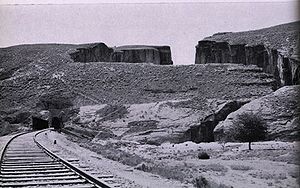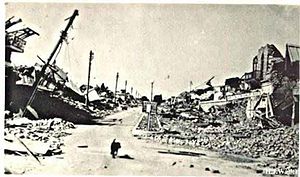
1935 Balochistan earthquake
Encyclopedia

Baluchistan (Chief Commissioners Province)
The Chief Commissioner's Province of Baluchistan was a province of British India located in the northern parts of the modern Balochistan province.- History :...
, British India
British Raj
British Raj was the British rule in the Indian subcontinent between 1858 and 1947; The term can also refer to the period of dominion...
(now part of Pakistan). The earthquake had a magnitude of 7.7 Mw
Moment magnitude scale
The moment magnitude scale is used by seismologists to measure the size of earthquakes in terms of the energy released. The magnitude is based on the seismic moment of the earthquake, which is equal to the rigidity of the Earth multiplied by the average amount of slip on the fault and the size of...
and anywhere between 30,000 and 60,000 people died from the impact. This ranks as one of the deadliest earthquakes that hit South Asia
South Asia
South Asia, also known as Southern Asia, is the southern region of the Asian continent, which comprises the sub-Himalayan countries and, for some authorities , also includes the adjoining countries to the west and the east...
. The quake was centred 4.0 kilometres South West of Ali Jaan
Ali Jaan
Ali Jaan is town in the Balochistan province of Pakistan, it is located at . It was near to the epicentre of the 1935 Balochistan Earthquake that struck on 31st May 1935....
, Balochistan, British India.
The earthquake
QuettaQuetta
is the largest city and the provincial capital of the Balochistan Province of Pakistan. Known as the "Fruit Garden of Pakistan" due to the diversity of its plant and animal wildlife, Quetta is home to the Hazarganji Chiltan National Park, which contains some of the rarest species of wildlife in the...
and its neighbouring towns lay in the most active seismic region of Pakistan atop the Chamman and Chiltan fault lines. A disturbance in the geological activity resulted in an earthquake early in the morning on 31 May 1935 estimated anywhere between the hours of 2:30 am and 3:40 am which lasted for three minutes with continuous aftershocks. Although there were no instruments good enough to precisely measure the magnitude of the earthquake, modern estimates cite the magnitude as being a minimum of 7.7 MW and previous estimates of 8.1 MW are now regarded as an overestimate. The epicentre of the quake was established to be 4-kilometres south-west of the town of Ali Jaan
Ali Jaan
Ali Jaan is town in the Balochistan province of Pakistan, it is located at . It was near to the epicentre of the 1935 Balochistan Earthquake that struck on 31st May 1935....
in Balochistan, some 153-kilometres away from Quetta in British India. The earthquake caused destruction in almost all the towns close to Quetta including the city itself and tremors were felt as far as Agra
Agra
Agra a.k.a. Akbarabad is a city on the banks of the river Yamuna in the northern state of Uttar Pradesh, India, west of state capital, Lucknow and south from national capital New Delhi. With a population of 1,686,976 , it is one of the most populous cities in Uttar Pradesh and the 19th most...
, now in India
India
India , officially the Republic of India , is a country in South Asia. It is the seventh-largest country by geographical area, the second-most populous country with over 1.2 billion people, and the most populous democracy in the world...
. The largest aftershock was later measured at 5.8 MW occurring on 2 June 1935. This however did not cause any damage in Quetta but the towns of Mastung
Mastung, Pakistan
Mustang the capital of Mastung District, is a town in the Balochistan province of Pakistan. It is located at 29°48'0N 66°50'60E and has an altitude of 1701 metres . The town is also the administrative centre of Mustang Tehsil, an administrative subdivision of the district - the town itself is...
, Maguchar and Kalat were seriously affected by this aftershock.
Casualties

Communique
A communiqué is a brief report or statement released by a public agency.Communiqué may also refer to:* Communiqué , a rock band* Communiqué , 1979* Communiqué , 1987...
drafts issued by the Government estimated a total of 20,000 people buried under the rubble, 10,000 survivors and 4,000 injured. The city was badly damaged and was immediately prepared to be sealed under the military guard with medical advice. All the villages between Quetta and Kalat were destroyed and the British feared casualty to be of higher numbers in surrounding towns; it was later estimated to be nowhere close to the damage caused in Quetta.
From memorabilia of a member of the Royal Signals in 1935:
"For long-distance military work, we used large rhombic set-ups, with heights of 50 to 75 feet. For amateur work a single-wire horizontal, with the feed at three-sevenths of the total length, was used. As a matter of interest, during the Quetta earthquake of 1935, all civilian radio nets were destroyed, and all traffic was taken over by R.Signals stations. We did over 168 hours of frantic communications from D.I.K. to Quetta; sleeping on the floor next to the equipment."
Infrastructure was severely damaged. The railway area was completely destroyed and all the houses were razed to the ground with the exception of the Government House that stood in ruins. A quarter of the Cantonment area was destroyed but military equipment and the Royal Air Force
Royal Air Force
The Royal Air Force is the aerial warfare service branch of the British Armed Forces. Formed on 1 April 1918, it is the oldest independent air force in the world...
garrison suffered serious damages. It was reported that only 6 out of the 27 machines worked after the initial seismic activity. A Regimental Journal for the 1st Battalion of the Queen's Royal Regiment
Queen's Royal Regiment (West Surrey)
The Queen's Royal Regiment was a regiment of the English and later British Army from 1661 to 1959. It was the senior English line infantry regiment of the British Army, behind only the Royal Scots in the British Army line infantry order of precedence...
based in Quetta issued on November 1935 stated,
It is not possible to describe the state of the city when the battalion first saw it. It was completely razed to the ground. Corpses were lying everywhere in the hot sun and every available vehicle in Quetta was being used for the transportation of injured … Companies were given areas in which to clear the dead and injured. Battalion Headquarters were established at the Residency. Hardly had we commenced our work than we were called upon to supply a party of fifty men, which were later increased to a hundred, to dig graves in the cemetery.
Rescue efforts
Tremendous losses were incurred on the city in the days following the event. On streets, people lay dead, buried beneath the debris some still alive. British regiments were scattered around town to rescue people, an impossible task as 1st Queen's remember. While assisting in rescue efforts, Lance-Sergeant Alfred LungleyAlfred Lungley
Alfred Herbert Lungley, GC was a British soldier of the Royal Artillery who distinguished himself during rescue efforts after the Quetta earthquake of 1935.Lungley was born in Colchester, Essex, on 20 October 1905...
of the 24th Mountain Brigade earned the Empire Gallantry Medal
Empire Gallantry Medal
The Medal of the Order of the British Empire for Gallantry, usually known as the Empire Gallantry Medal , was a British medal awarded for acts of the highest civilian gallantry . King George V introduced it on 29 December 1922...
for highest gallantry.
The weather did not prove to be of much help and the scorching summer heat made matters worse. Bodies of European and Anglo-Indians were recovered and buried into a British cemetery where soldiers had dug trenches. Padres performed the burial service in haste as soldiers would cover the graves quickly. Others were removed in the same way and taken to a nearby shamshāngāht for their remains to be cremated
Cremation
Cremation is the process of reducing bodies to basic chemical compounds such as gasses and bone fragments. This is accomplished through high-temperature burning, vaporization and oxidation....
.
While the soldiers excavated through the debris for a sign of life, the Government issued the Quetta administration with instructions to build a tent city to house the homeless survivors and to provide shelter to their rescuers. A fresh supply of medicated pads was brought forth for the soldiers to wear over their mouths while they dug for bodies in fears of a spread of disease from the dead bodies buried underneath.
Significance
The natural disasterNatural disaster
A natural disaster is the effect of a natural hazard . It leads to financial, environmental or human losses...
ranks as the 23rd most deadly earthquake worldwide to date. In the aftermath of the 2005 Kashmir earthquake
2005 Kashmir earthquake
The 2005 Kashmir earthquake was a major earthquake centered in Pakistan-administered Kashmir known as Azad Kashmir, near the city of Muzaffarabad, affecting Gilgit-Baltistan and Khyber Pakhtunkhwa province of Pakistan. It occurred at 08:52:37 Pakistan Standard Time on 8 October 2005...
, the Director General for the Meteorological Department at Islamabad
Islamabad
Islamabad is the capital of Pakistan and the tenth largest city in the country. Located within the Islamabad Capital Territory , the population of the city has grown from 100,000 in 1951 to 1.7 million in 2011...
, Chaudhry Qamaruzaman cited the earthquake as being amongst the four deadliest earthquakes the South Asia
South Asia
South Asia, also known as Southern Asia, is the southern region of the Asian continent, which comprises the sub-Himalayan countries and, for some authorities , also includes the adjoining countries to the west and the east...
n region has seen; the others being the Kashmir earthquake in 2005, Pasni
Pasni City
Pasni is a medium-sized town and a fishing port in Gwadar, Balochistan, Pakistan. Its population is around 33.000. It is located on the Makran coast on Arabian Sea about 300 km from Karachi...
earthquake
1945 Balochistan earthquake
The 1945 Balochistan Earthquake was an earthquake which occurred in British India at 05:26 PST on 28 November 1945 It was recorded with a magnitude of 8.1 on the Richter Scale....
in 1945 and Kangra earthquake in 1905.

